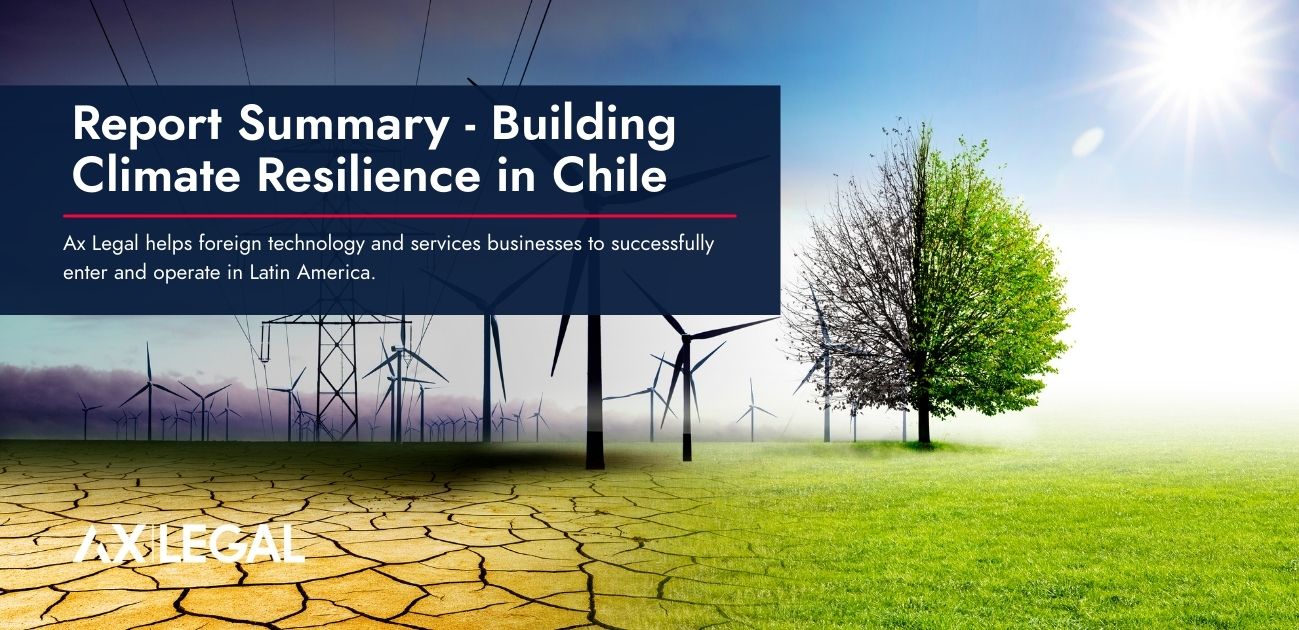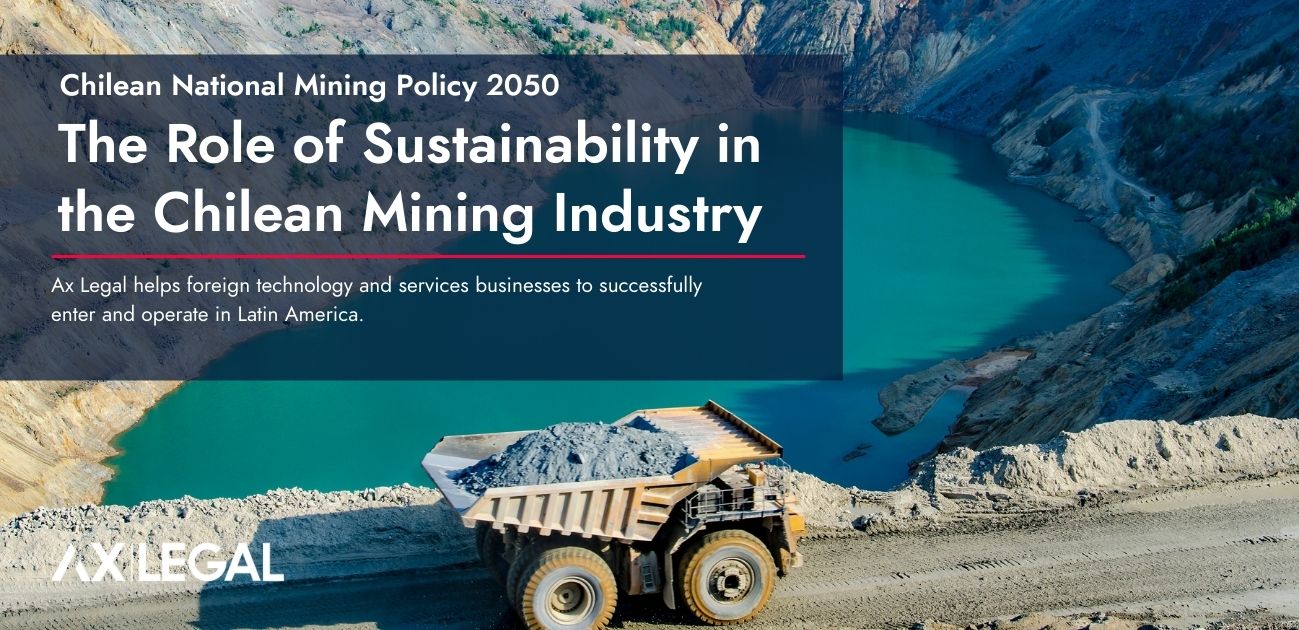Report Summary – Building Climate Resilience in Chile
Chile, a country with diverse climates and landscapes, is experiencing impacted significantly from climate change. Stretching from the arid Atacama Desert in the north to the icy expanses of Patagonia in the south, Chile’s unique geography makes it particularly vulnerable to environmental changes.
The effects of climate change are more and more evident. The country has faced a drought that has stretched out over 10 years, record breaking heat waves, larger and more intense forest fires, and the melting of glaciers that provide potable water. The frequency of these events are increasing each year.
As one of the world’s leading copper producers and a major agricultural hub, Chile’s economy is deeply intertwined with its natural resources. The change in climate has far-reaching impacts on various industries that are crucial to Chile’s economy. As climate change progresses, these industries must navigate the challenges posed by changing precipitation patterns, rising temperatures, and more frequent extreme weather events.
The International Energy Agency (IEA) recently released a report that provides recommendations on how Chile can build climate resilience. It outlines some great examples of where indsutries will or have already been impacted.
Key Findings
- From 1961 to 2022, average surface temperatures in Chile increased at a rate of 0.15°C per decade. This rate has accelerated in recent decades from 1981‑2022 to 0.18°C per decade. As a result, Chile had 12 consecutive warmer-than-normal years starting in 2011 and experienced eight of the ten warmest years in Chile’s history in the last two decades.
- Experts project that Chile will experience warming through the end of the century under all emissions scenarios. In a low-emissions scenario (below 2°C), Chile’s average land surface temperature is expected to rise by 1.72°C by mid-century and 1.78°C by the end of the century compared to pre-industrial levels. In a high-emissions scenario (above 3°C), the warming is projected to be 2.2°C by mid-century and 3.7°C by the end of the century.
- Since 1961, precipitation in Chile has declined at an overall rate of 26 mm per decade, though changes have varied by region. The decrease was more notable in the southern and central zones of the country,
- Along with the decrease in overall precipitation, Chile has been severely affected by droughts. Chile experienced a mega-drought in 2010‑2015 that had drastic consequences for the country’s water resources, with some reservoirs reaching record lows and the area affected by forest fires increasing 70%. Experts attribute about 25% of the precipitation deficit during this drought to climate change.
- Precipitation is projected to decline across Chile, although changes will continue to vary across the country. Under a low-emissions scenario (Below 2°C), precipitation is projected to decrease by an average of 6% across the country by the end of the century. Some regions in the central region will experience more than 14% declines in precipitation, while others will experience a less than 4% decline.
- The IPCC projects that sea level rise will continue across Chile’s coastline, though its magnitude will vary. Sea level rise will range from 0.2 m to 0.4 m by the end of the century in a low-emissions scenario (Below 2°C) and from 0.3 m to 0.6 m in a high-emissions scenario (Above 3°C), compared with a baseline period of 1995‑2014. As sea levels around Chile continue to rise, they can erode the coastline and damage coastal infrastructure.
- According to a Chilean Environment Ministry study, 28 out of 35 beaches have already experienced erosion, with some experiencing more than 1.5 m of shoreline retreat per year. A study commissioned by Chile’s Environment Ministry found that some energy infrastructure (notably two substations, a thermal power plant and eight fossil fuel distribution centres) would be exposed to floods by 2045 due to their low-elevation levels and proximity to the coast.
Impact on Key Industries
As climate change progresses, these industries must navigate the challenges posed by changing precipitation patterns, rising temperatures, and more frequent extreme weather events. Proactive measures and adaptive strategies will be crucial to sustaining Chile’s economic vitality and environmental health in the face of climate change.
Mining Industry
- The mining sector is highly sensitive to climate change, especially due to its reliance on water and energy. Both copper and lithium extraction are projected to grow in the future but the processes for extracting these critical minerals are water intensive.
- Currently, about 80% of copper output in Chile is produced from mines in water-stressed areas, which are vulnerable to decreasing precipitation and droughts.
- During severe droughts in 2019, the El Teniente mine, the largest underground copper mine in Chile, implemented water rationing to deal with severe droughts. BHP’s Cerro Colorado copper mine was ordered in 2022 to stop pumping water from their aquifers for 90 days. Antofagasta Minerals the same year had to cut its copper production targets. Anglo American’s Los Bronces copper output decreased by 28% in 2019, due to a 44% decline in the plant’s processing capacity because of lack of water.
Electric Industry
- The electric industry faces challenges related to both energy production and infrastructure. Extreme weather conditions can affect power generation, especially from renewable sources like hydroelectric power, which is crucial for Chile. Adapting grid systems to withstand these impacts is essential to maintaining a reliable electricity supply.
- Chile’s energy system is likely to observe a shift in peak electricity demand due to the changes in climate and demand patterns. Rising temperatures would decrease the peak electricity demand during winter by reducing the need for heating, while increasing peak electricity demand in summer with the proliferation of cooling technologies.
- Most hydropower plants are installed in central regions, where a decrease in precipitation is the most notable. In the 3°C and above 3°C scenarios, at least 70% of installed hydropower capacity in Chile is projected to be exposed to a moderately or significantly drier climate by the end of the century.
- If no additional resilience measures are implemented on time, IEA models project that Chile’s hydropower capacity factor may decline by around 25% until the end of the century under a high-emissions scenario (Above 3°C). Even under a low-emissions scenario (Below 2°C), Chile’s hydropower capacity factor is projected to decline by 14%.
- Thermal power plants, which account for over 40% of electricity generation in Chile, will also be affected by decreases in precipitation levels. Drought can contribute to water shortages that impact the availability of cooling water for coal and gas power plants. In 2014, for instance, a drought left several natural gas power plants without sufficient cooling water, leading some to curtail generation and others to seek water from private wells in order to continue operations.
- In 2016, three major gas plants totalling nearly 2 000 MW had to implement new drought preparation plans to prevent future droughts like the one in 2014 from leading to major disruptions. In 2021, power companies Enel Chile and Engie had to revise their revenue projections for the year due, in part, to water shortages. Enel Chile lowered its annual earnings expectations by USD$300 million, and Engie’s profits decreased 55% year-on-year in the first six months of 2021.
- Power generation assets near Chile’s coastline could be affected by sea level rise. Currently, around 30% total installed capacity of coal-fired power plants and 7% of natural gas-fired power plants are located in low-elevation areas and near coastal areas. Under a high-emissions scenario (Above 3°C), all low-lying coal-fired power plants and over 80% of natural gas-fired power plants are projected to experience 0.4 m to 0.6 m of sea level rise by the end of the 21st century.
Conclusion
For Chile, building climate resilience is crucial not only for managing risks but also for seizing opportunities to strengthen its energy, mining, and infrastructure sectors. In fact, the Chilean mining and energy sectors are well known around the world for their bold moves towards more sustainable practices.
The Chilean mining industry has been moving towards water sourced from desalination plants or the direct use of salt water within their operations. To date, of the 24 desalination plants that exist, 17 are intended only for mining. By the end of the decade, there is expected to the 34 plants in total operating in Chile.
Currently, the copper mining industry uses 37.2% of seawater for its production processes and it is projected that in 2034 this will double, increasing to 69.8% of the total water it uses.
In addition, Chilean miners have moved towards renewable energy, canceling contracts from gas and coal fired plants. Already in 2023, 66.6% of mining electricity consumption is from clean sources and in 2026, 78.1% of the industry’s electricity demand is expected to come from renewable energy.
In terms of the energy industry, Chile has been a great example of what countries can achieve when they take advantage of the resources they have. The result has been a huge explosion in wind and solar projects which have dramatically increased capacity year over year. It has done so without any major government subsidies which is a major accomplishment.
For example, during 2023, 102 new solar/wind projects and storage systems were installed, totaling 1,827 MW. As of December 2023, there were 374 projects under construction for a total of 6,806 MW.
Chile recognizes that climate change is impacting the country and will continue to do so into the future. It has taken steps to ensure that climate resilience considerations are embedded in planning and development processes for mining, energy, and infrastructure projects.
Most importantly, the industries that are pillars to the Chilean economy, the very ones that needs to be preserved from the threat of climate change, are taking a lead with moving the country towards a more resilient future.
Ax Legal helps industrial technology, engineering, and service companies to navigate the legal and commercial aspects of operating their business in Latin America. With deep knowledge of the industrial and natural resource sectors, we provide actionable and practical advice to help streamline our clients’ entries into Latin America, improve how they operate in the region, and to protect their interests.
Over the years, our team of legal and commercial advisors have developed a track record of working with companies of all sizes from Australia, Canada, the U.S., and Europe. The one common factor that connects our clients is that they are leaders in their field, providing innovative technologies and services to the industrial sectors.
To better understand how we can support you in the Region, please contact Cody Mcfarlane at cmm@ax.legal




 Santiago
Santiago Sydney
Sydney Lima
Lima